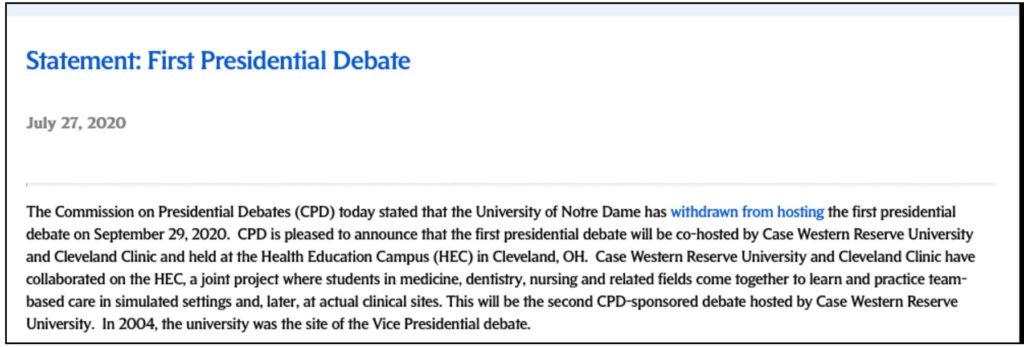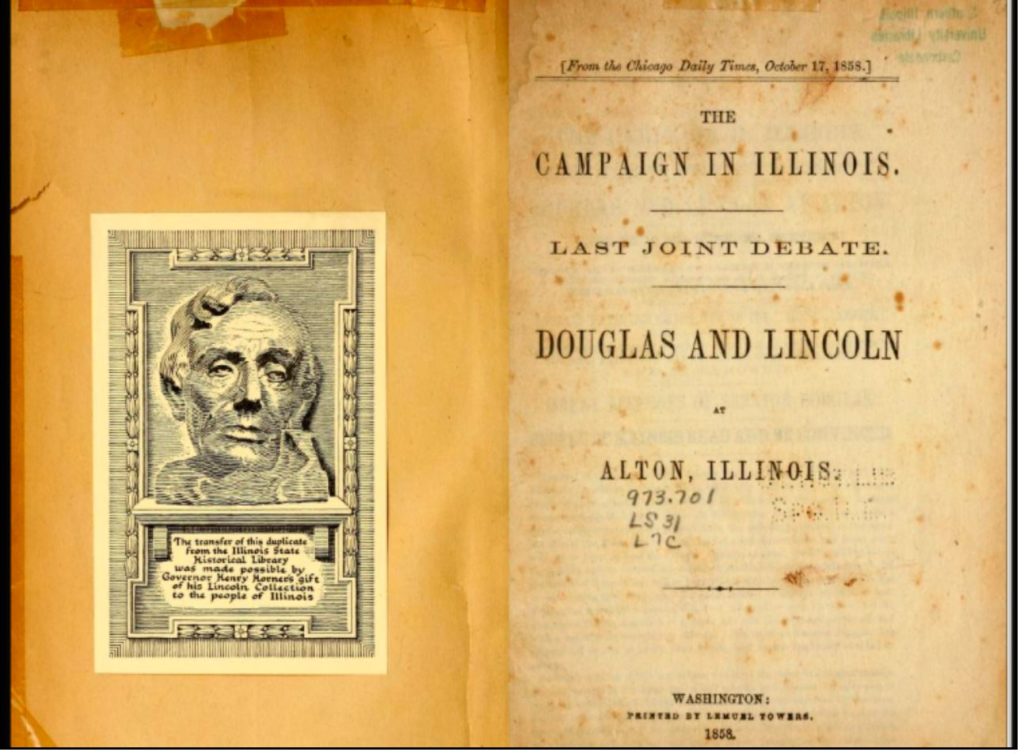One of the unique aspects of the US Presidential election is the face to face debate of the Presidential nominees. The debates are seen as an important opportunity for the candidates to put forth their points of view and for the independent voters to make up their mind. Here is an explainer on the history & format of these debates.
The United States of America (USA) is one of the oldest modern democracies in the world. Over its existence as a democracy for nearly two and half centuries, it has developed institutions and practices which strengthen the idea of democracy. Democracy wrests the choice in the people to choose a government to preside over the administration. Hence it is imperative that the people know about the political party or the individual that they would be voting for. This knowledge includes – the ideology, stance on various issues, vision etc.
In a Presidential democracy like the USA, the individual attributes of the contesting candidates may have a larger bearing than that of the political party, compared to that of a parliamentary democracy where it is vice-versa in most cases.
In the USA’s presidential election, knowing about the vision, attributes and plans of the presidential candidate becomes key for the non-partisan voters to decide, who play a key role in the election of the President.
As such, the US Presidential debates provide a platform for the voters to gain more insights about the presidential candidates. On the other hand, it gives a final opportunity to the candidates to present their point of view to the electorate. Over the past many decades, presidential debates have become a common fixture in the Quadrennial US Presidential elections.
With the first of the Presidential debates in the run up to US Presidential Election 2020 coming up later this month, we take a look at the history of the presidential debates, their framework and related information.

The first General election presidential debate was held in 1960
US Presidential Debates are not constitutionally mandated but have become an integral part of presidential elections. The first Presidential Debate was held in 1960, between Democratic Presidential nominee John F. Kennedy and Republican Nominee and Vice-president Richard M. Nixon. However, there are several others debates which are considered to have set the precedent to this debate.
Lincoln-Douglas debates – 1858
The series of seven debates in 1858 between Abraham Lincoln & Senator Stephen Douglas, for United States Senate in Illinois, are considered to be the first face to face debates between two candidates. Although, they both were contesting for the Senate in 1858, they both were nominated for president in 1860 and the debates defined the respective positions in the ensuing presidential election in 1860.

Republican Presidential primary debate – 1948 and debates in ensuing primaries
Although Republican presidential nominee in 1940, Wendell Willkie challenged his opponent, President Franklin Roosevelt, to a face to face debate, it was refused by the later. However, in 1948, candidates during Republican Presidential Primaries, Thomas.E. Dewey and Harold Stassen, engaged in a debate in Oregon, which was broadcasted on radio. This was followed by Democrats in their primaries during 1956. A televised primary debate was conducted between Adlai Stevenson and Estes Kefauver. There was another debate in 1960, again during Democrat Primaries, this time involving John F. Kennedy and Hubert Humphrey.
Kennedy – Nixon debates in 1960 – The first presidential debates
While there have been efforts since 1956, to organize debates with the presidential candidates, it materialized during the Presidential elections in 1960. The first general election presidential debate was held on 26 September 1960 between U.S Senator John F. Kennedy (Democratic nominee) and Vice President Richard M. Nixon (Republican Nominee), at CBS’s studio. There were three other debates which followed.
The series of debates were sponsored by broadcasting networks – CBS, ABC and NBC. The moderating panel consisted of reporters & journalists and varied with each debate. Political observers have commented that Kennedy’s better performance in the first debate gave him an edge in the presidential contest, in spite of his relative inexperience to Nixon. The first debate had over 66 million viewers, more than the following three, with each of them also crossing 60 million in viewership.

Hiatus and resumption of the presidential debates in 1976
After the 1960 elections, it took 16 years to organize another presidential debate, with the next presidential debate being in 1976 between President Gerald Ford (Republican) and his opponent, Democratic nominee, Jimmy Carter. During this gap period, there have been face to face debates organized within the party primaries, especially Democratic primaries.
League of Women Voters sponsored the debates during the 1976 election campaign, unlike the 1960 debates, which were sponsored by television networks. These debates were televised, and 3 debates were organized between the presidential candidates. There was also one debate which was organized between the vice-presidential candidates. This was followed up in the next presidential elections of 1980 and remained a regular fixture in every presidential election ever since. Since 1984, debate between Vice-presidential candidates also became a regular feature.
Most of the presidential debates were organized between the presidential nominees of the two leading parties i.e. Democratic & Republican parties. The year 1992 was an exception, with third party candidate Ross Perot, also being part of the debates along with President George Bush (Republican) and Bill Clinton (Democrat).

Commission on Presidential Debates (CPD) is sponsoring the debates since 1988
As highlighted earlier, presidential debates are not constitutionally mandated, but are an initiative by media and civil society. The first General Election Presidential Debates in 1960, were organized and sponsored by the broadcasting networks i.e. CBS, ABC and NBC. In 1976, a non-partisan civic organization, League of Women Voters (LWV) took the initiative and sponsored the debates in the run-up to 1976 presidential election. They continued with organizing the presidential debates for the next two elections i.e. in 1980 and 1984. However, they withdrew from debate sponsorship for 1988 elections, citing the imposition of the major party candidates on how the debates were conducted.

The two major political parties in USA, took control of organizing the presidential debates through the Commission on Presidential Debates (CPD). Since inception, CPD has been headed by former chairs of Democratic National Committee and Republican National Committee. Since the 1988 presidential elections, CPD has sponsored presidential debates for all the ensuing elections.

The format of the debates has changed over the period of time
The format of debates has significantly changed over the years. Each debate during the initial Lincoln vs Douglas debates lasted 3 hours, with the first speaker speaking for an hour followed by the second speaker given time for 1 and half hour. The first speaker was then given 30 minutes for rebuttal.
- The first general elections presidential debates in 1960 followed different formats in each of the debates. The first & last debates had opening & closing statements, while the two debates in middle had each of the candidates taking turns to answer the questions posed. This debate was moderated by a panel of journalists.
- The debates organized by LWV followed an approach, where in the candidates were posed questions in turns for them to answer. Each of these debates had a moderator.
- The CPD, retained the same format in 1988. However, they introduced town hall in 1992, where select citizens were provided the opportunity to ask questions.
- In 2000, the CPD brought about a change in the format, with the candidates sitting across the table along with the moderator rather than having separate podiums.
- In 2012 & 2016, different formats were used for first & last debate. The two debates were divided into six segments of 15 minutes each, with each of the candidate discussing one-major issue facing the country. One debate was dedicated to domestic topics and the other for foreign affairs.
The CPD uses three criteria in its selection of the moderators:
- Familiarity with the candidates and the major issues of the presidential campaign
- Extensive experience in live television and broadcast news
- An understanding that the debate should focus maximum time and attention on the candidates and their views.
The moderators are announced several weeks before the debates and they select the questions to be asked, which are not known to either the CPD or to the candidates. Except for a couple of exceptions, a single moderator was used for a debate.
3 presidential and one Vice-presidential debate to be held for 2020 Presidential elections
The CPD, sponsor for the presidential debates reserves the right to determine the dates and the venues for the presidential debates. For the ongoing Presidential election, there would be three presidential debates and one vice presidential debate. The first debate would be on 29 September 2020. The incumbent president Donald Trump is the Republican nominee and former Vice President Joe Biden is the Democratic party’s nominee for the president. All the debates have a time limit of 90 minutes.

Lack of representation of non-major party candidates has attracted criticism
The CPD has laid down criteria for the presidential candidates who can participate in these debates. With the exception of Ross Perot, an independent candidate in 1992, the debates have been between the presidential nominees of the two major parties – Democrats & Republicans. The presidential candidates are required to get at least 15% of the votes in opinion polls to be invited for the debates.
As per its 2020 Nonpartisan Candidate Selection Criteria, the candidate is required to:
- Be constitutionally eligible to hold office of the President
- Appear on sufficient number of State ballots to have mathematical chance of winning a majority vote in the Electoral College
- Have a level of support of at least 15% of the national electorate, as determined by five national public opinion polling organizations
Even prior to the release of these standard criteria in 2019, the 15% share in the electorate has rendered third party candidates like those from Green Party & Libertarian Party along with independents unqualified to be part of the debates. This has long been contested and the lack of exposure on TV debates is cited as one of the reasons for getting lower poll numbers in presidential elections. The grouse expressed by third party candidates and independents, finds support in a study by PEW research, where an increasing number of participants state that the debates have aided in making up their minds. This indicates that the debates have an impact on the non-partisan electorate, who are the main focus for third-party candidates and independents.
Featured Image: US Presidential Debates


